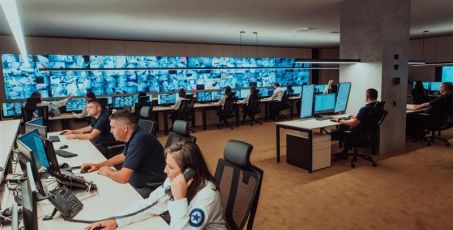Beyond the Walls: Rethinking Justice and Corrections Through Technology
17/10/25, 11:00 am
Beyond the Walls: Rethinking Justice and Corrections Through Technology
The justice and corrections sector is being asked to do the near impossible: manage increasing complexity with fewer resources while delivering better outcomes under greater scrutiny, and rapid change. The stakes are high. Every decision has the potential to alter the course of a life, and every gap in the system carries consequences for individuals and communities.
There is an opportunity for technology to form the foundation of a stronger justice and corrections system – but only when it’s built by design, fully integrated, and shaped around outcomes. Its success will be measured by its impact: sharper decisions, safer facilities, and stronger pathways for rehabilitation. With decades of experience in Australian corrections — and new insights from Marco Fiorentino, Executive Director of NEC Digital Studio — NEC is exploring how technology can shape the future of justice and corrections.
AI & Automation: A Super Colleague on the Frontline
AI and automation are at their best when they take on the work no one has the time – or capacity – to do. They don’t replace the human; they supercharge them. And while decision-making will always remain in human hands, AI’s role in justice is to provide clarity and consistency, while automation delivers speed and efficiency.
Automation removes the bottleneck of routine tasks: summarising case notes, transcribing hearings, and syncing information across agencies instantly. AI connects the dots across vast datasets – finding risk patterns in years and thousands of records, reviewing hours of video to isolate key moments, and flagging triggers staff can act on early.
For probation officers that means earlier warnings; for corrections staff, anticipating flashpoints; and, for governments and operators, more consistent decisions, better resource use, and accountability, even under scrutiny.
But even as technology evolves, its value depends on the humanity behind it.
“The reasons people end up in the criminal justice system are deeply human – relationships, loss of control, survival. And it follows that humanity should also be at the centre of desistance: connection, learning, change. Our approach to AI is to make space for those human moments to grow,” says Marco Fiorentino, Executive Director of NEC Digital Studio.
“Technology should help people connect, understand each other, and play a leading role in their own journeys – not keep them behind a screen.”
Discover more on AI and automation in NEC’s whitepaper ‘The Role of AI in the Human World of Justice’
Software for Safety, Not Bureaucracy
A modern justice system doesn’t run on paper files and manila folders. Yet too many digital systems recreate the filing cabinet – built for data storage, not insight. In justice and corrections, inefficiency quickly becomes a liability, which is why fit-for-purpose software is essential.
Case and records management tools provide a secure source of truth for offender information, evidence and outcomes. When data flows seamlessly between agencies, it creates a single, connected view of the person in the system – reducing duplication, closing information gaps and critically, giving practitioners the context they need to understand risk, track interventions, and align rehabilitation and reform efforts.
Today’s software ecosystem goes further: tools that capture interviews, track programmes, automate transcription and redaction, and even streamline digital mail handling, strengthen consistency, reduce risk, and free staff from repetitive manual tasks. For frontline staff, that means fewer hours lost to duplication and manual processes – freeing them to spend more time delivering direct support and interventions. Tor agencies, it means decisions backed by complete, reliable data, with compliance built into the way they work – enabling smarter resource allocation, clearer accountability and stronger outcomes across agencies.
Software is the steady hand of modern justice – reducing risk, improving consistency, and keeping the system moving.
“At NEC Digital Studio, technology is an enabler, not the centrepiece,” Marco adds. “It works quietly in the background so people can do what they do best – connect, use their judgment, and make human decisions.”
“Human-centred design isn’t just a method for us – it’s a mindset. Our expertise in criminal justice grounds that mindset in empathy, context, and connection. Technology plays its part, but the real work happens between people.”
Inside the Walls: Digital Infrastructure in Correctional Facilities
Walls and bars may still define the perimeter of traditional correctional facilities, but digital infrastructure now defines daily life inside. From biometric access to secure networks and inmate platforms, technology is the framework that shapes safety, connection, and rehabilitation for those on both sides of the walls.
Every digital service in a facility – from calls home to rehabilitation, monitoring and daily operations – depends on robust connectivity. Secure network and communication infrastructure transforms separate tools into an integrated system. In some of Australia’s largest prisons, NEC has delivered managed networks with hundreds of access points, switches, and devices, paired with surveillance and communications upgrades. That foundation enables secure, integrated communication: officer calls, inmate messaging, and video links with family or legal representatives. For staff, it means confidence in systems, reduced conflict, and improved oversight whilst maintaining vital connections within secure boundaries. For people in custody, it means reliable access to education, communication, and support programs – all critical to effective rehabilitation.
Security is also no longer just about physical barriers – gates, bars and huge sets of keys. It’s about knowing exactly who is accessing what, and when. Biometric technologies such as facial and fingerprint recognition ensure accurate identification of staff, visitors, and people in custody, reducing the risk of fraud or error. Combined with automated access control and real-time alerts, they prevent unauthorised movement, protect restricted areas, and give staff confidence that facilities are secure. Just as importantly, strong digital identity safeguards every other service inside – ensuring education, communication, and rehabilitation tools are delivered safely and fairly.
Daily life in custody is shaped as much by access to services as it is by physical security, and increasingly, those services are delivered digitally. NEC’s Digital Inmate Services Platform offers controlled access to education, entertainment, retail, and communication via kiosks, tablets, or IPTV. By bringing services together in one secure, flexible platform, correctional facilities can focus can spend less time managing systems and more time on creating conditions that support positive outcomes.
Discover more about NEC’s solutions supporting Justice and Corrections
Final Thoughts
Modern justice technology isn’t about adding more systems or complexity. It’s about integration, purpose, and outcomes: sharper decisions, safer environments, and effective rehabilitation. As governments and operators look ahead, the question isn’t how much technology to adopt – it’s how well it’s applied to deliver outcomes that matter in communities. The systems that will matter most are those built around people: secure enough to be trusted, flexible enough to adapt, and powerful enough to change lives.




